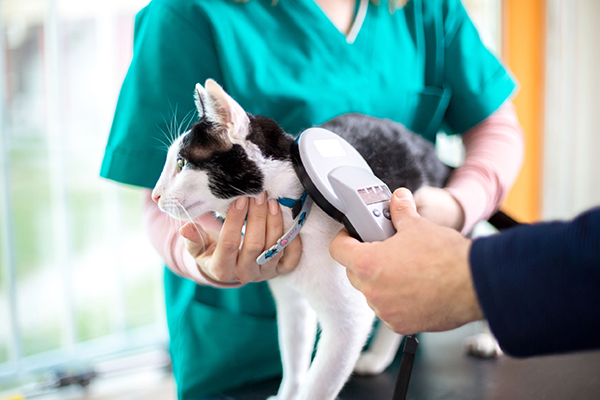

Fortunately, most lost pets are found within several blocks of their homes. But unless your pet has adequate identification it will be impossible for the kind human who finds your pet to return them to you.
Every pet should have a collar and tags, if possible. Make sure that the information on your pet’s tags is kept current at all times.
For dogs and cats there are rabies tags (required for cats in some states), license tags, and identification tags.
Rabies Tags
Rabies Tags have a number, the year the shot was administered, and the veterinary office where the shot was given.
License Tags
License tags have a number and tell where the animal was licensed. Your pet’s license number can be reported to animal control in the county where the license was issued to obtain the owner’s information.
Identification Tags
Identification tags typically have the phone number and address of the owner on the tag. Available in many adorable shapes, like dog bones, bows etc.
Disadvantages: Tags and collars if not secure, can fall off and they are easily removed by dishonest people and can be thrown away. Information can wear off of a tag and become illegible.
Tattooing
Tattooing is a permanent means of identification available for some pets. Your animal is tattooed with a series letters and numbers. The inside of the hind legs or belly are the most common places to tattoo. It is a good idea to keep the tattooed area shaved for maximum visibility. The insoluble dyes in tattoo inks will not react with blood or tissues. Black ink is preferable for light-skinned animals, and green ink is better for those with darker-skin. If you decide to have your animal tattooed, consult your vet, breeder, or local humane society.
Like microchips, tattoos must be registered on sites such as BeKind PetFind to be traced to your pet.
Disadvantages: Tattoos can be hard to find; most people are not aware of tattooing animals, so they won’t look for a tattoo. Also, they can be altered with a permanent marker. If you move, you must remember to update your contact information with the registry. Tattoos are not reliable as the only method of identification for your pet; they’re best when combined with collars, tags and microchipping.

Microchips
Microchips are the high-tech solution to animal identification. About the size of a grain of rice, the microchip contains a coded number and is encased in a biologically inert substance so it can remain under the skin for a lifetime.
Microchips cannot be lost, changed, or removed.
Typically, the microchip is implanted in the loose skin between an animal’s shoulders. The procedure is virtually painless. No maintenance is needed, and the microchip will last for about 100 years. Microchips should be implanted by a licensed veterinarian. Veterinarians and shelters use hand-held scanners to detect the microchip and read the code. The appropriate registry (hopefully, BeKind PetFind) is contacted and the owner is reunited with their best friend. Several different companies produce microchips, but the universal scanners can read all microchips.
Disadvantages: The kind human who finds your animal may not know about microchips or where to take an animal to be scanned. (You should take a lost pet to a veterinarian or a shelter to be scanned). You must remember to keep your contact information with the registry current. It is best to use a microchip to protect your pet in conjunction with collars and tags to provide the most comprehensive protection.
GPS Trackers
GPS Trackers pick up signals from orbiting satellites to pinpoint locations. They transmit your animal’s exact location. Some pet tracking GPS systems offer email and text message notifications and online mapping. Worn outside an animal’s body, GPS devices are heavier than a collar tag. They can also alert you when your dog strays.
Disadvantages: GPS Trackers are substantially more expensive than microchips and require a monthly subscription fee. Batteries need to be recharged or replaced frequently.
Some of the devices are water resistant, but not necessarily water proof. They can be unreliable because some areas have little or no cell phone coverage or connectivity. Some trackers are too big and heavy for smaller animals. In addition, GPS devices can be lost.
Conclusion
There are many options available to keep track of your pet. No one method is entirely effective. Most of us don’t live where it’s entirely safe to let our pets roam free. A securely fenced yard, an up to date ID tag on your pet’s collar and a combination of other methods that work for your pet and lifestyle are ways to greatly increase the return of your best friend.
Make sure you always have a current color picture of your pet and a record of her height, weight, coloring, and distinguishing marks. Having this information at your fingertips is crucial if your pet should become lost.
Registering your pet’s information on a reliable, trusted pet registry like BeKind Petfind is the BEST way to insure that you are reunited with your best friend if they should ever become lost.


